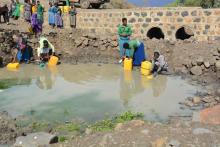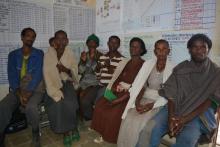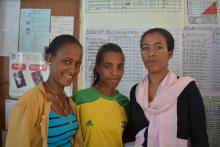Ethiopia - Scabies outbreak response in Amhara regional state
Belaynesh Yimer is a 14-year-old girl and seventh grader, in Tenta kebele (district) of Enebssie Sarmidir Woreda of Amhara state. She wants to be a doctor and heal patients. One day, she could not stop scratching herself and her body was aching. She could not sleep, study, write and eat properly. She could not hold a pen due to the sores on her hand. Consequently, she missed several days of school.
“I told of the incident to my parents and they brought me to this health facility. I didn’t believe I would be healed because the pain was intolerable. The doctors gave me an ointment to apply on my body. They told me what I have to do to be cured and to protect others against contamination. I did what I was advised and now I am healed and happy to go to school.” She said
Belaynesh is one of the 373,000 people in Amhara state who were affected by the Scabies outbreak. WHO team has visited the scabies affected areas from 22-24 March 2016. In a focus group discussion with Tenta kebele community, the local people said that scabies has gravely affected their lives. “We can’t perform our routine activities and our lives have been compromised. We can’t sleep the whole night as the pain worsens in the evenings. We couldn’t feed our children and prepare food,” they said. One nursing mother said that she could not even breast-feed her baby properly as the infant was also suffering from scabies.
Tenta Kebele health extension workers, Tsehay Chane, Atalay Gashaw and Atalay Yigrem remember the difficult days. They provided medical treatment for 1,691 people out of the general kebele population of 6,495. They said that they did not only give the prescribed medicines to the community, they also raised their awareness on how scabies is transmitted and can be prevented from passing from one person to another.
“We started working very early at 6:30 AM through 7:30 PM. It was very tiresome. We had to travel as far as two hours by foot and if we didn’t finish our assignments, we would stay the night there. We treated 200 people per day. We are proud to be a part of this great effort to stop the spread of scabies,” Tsehay Chane said smiling. She also noted that lack of water caused by the drought significantly contributes to outbreaks of scabies, as the community does not have enough water to use for personal hygiene
Cases of scabies were first identified In Amhara in October 2014 in Waghimra woreda. The disease eventually spread and became a serious health issue, as other woredas also began to reportcases, which culminated into outbreaks. Scabies disease has been reported in all parts of Amhara region except Awi Zone and Dessie town.
Ato Getaneh Desalegn, Public Health Emergency Management core Process Preparedness Officer at the Amhara health bureau said Scabies outbreaks have been reported in 76 woredas and more than 373,000 scabies patients were provided with medication as per WHO recommendations and national guidelines. This involved mass drug administration at the community level. Sulphur, Ivermectin, Benzyl Benzoate Lotion (BBL) were the drugs given to patients.
The Amhara health bureau is working very closely with the regional Water Irrigation and Energy Development Bureau to fight scabies. Accordingly, the two bureaus have done a remarkable job in developing a water map of the health facilities in the region and did water rationing for health facilities that has no water coverage.
Scabies awareness-raising efforts are underway and currently, a Radio spot has been produced and transmitted on Amhara radio. This is in addition to the IEC materials on scabies distributed in the region.
Currently the status of scabies shows improved results in the region due to the steep decline in number of cases. But there are woredas that still report incidents of scabies.
Challenges/gap
One of the major gaps was that the disease was not reported early enough and as it unfolds. Furthermore, due to the nature of the highly contagious disease, it did not take long for outbreaks to occur. Despite huge efforts by health authorities to prepare themselves for such outbreaks, there was an insufficient supply of medicines to treat those who fell ill, - outbreaks had not previously been as intense, affecting a large number of people. .The intensity of outbreaks coupled with logistical challenges, led to inconsistencies in the completion of a two-round dosage treatment against scabies Logistics remains a problem. Data quality is another challenge, and WHO is looking to support the health bureau to improve timeliness and completeness of reporting.
Partnership
With the leadership of the regional health bureau, development partners play an important role in curbing the spread of disease. WHO provided two capacity building trainings following the scabies outbreak. The first one was conducted from July to October 2015, training 600 health workers on scabies case management and control. WHO also trained 58 woreda Nutrition and Public Health Emergency surveillance officers on scabies surveillance. In addition to the training, a scabies campaign was conducted and WHO recommended treatments and national guidelines were provided. Save the children and Plan international bought and imported Sulphur and Benzyl Benzoate Lotion (BBL). UNICEF supplied medication and IEC materials about scabies. Bahir Dar University played an important role in adapting scabies management and control guidelines. Currently, universities, with the consent of the regional health bureau have begun to support the community by conducting surveillance activities and by investigating scabies.
The regional health bureau appreciated the development partners’ support and stated it needs more assistance especially in the area of logistics and technical support.
Note:
Human scabies is a parasitic infestation caused by Sarcoptes scabiei var hominis. The mite, barely visible to the naked eye, burrows into the epidermis and lays eggs, triggering a host immune response that leads to intense itching in response to just a few mites. Globally, it affects more than 130 million people at any time.
For more information, please contact
Biniyam Fisseha
Communication Officer
email: fissehab [at] who.int" target="_blank">fissehab [at] who.int
Tel: +251 911 125472



